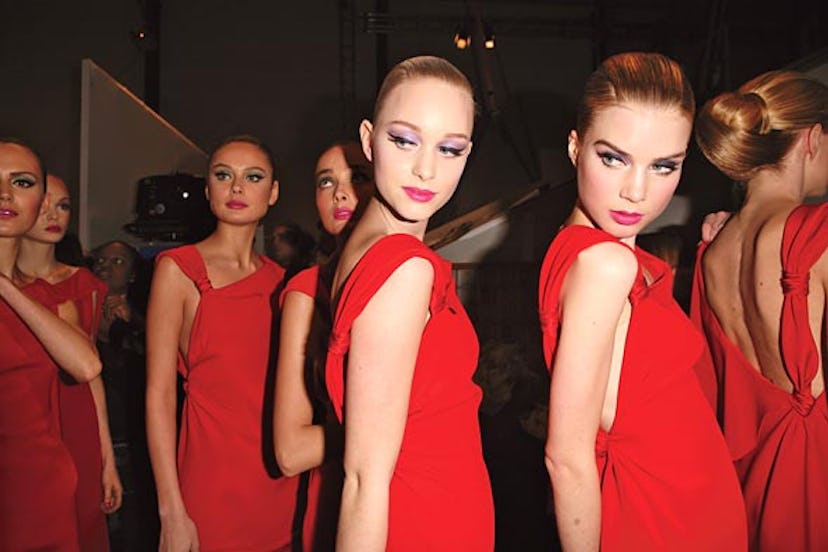A month before his January couture show for Chanel, Karl Lagerfeld gave makeup artist Peter Philips and hairstylist Odile Gilbert each a sumptuous picture book about shells, hoping to inspire them in concocting the delicate faces and bejeweled heads for his collection. Soon after, he handed them a sketch of a woman, hand-drawn in makeup, to illustrate his couture vision for summer.
Sequins at Dior.
Taking a cue from Lagerfeld’s pastel palette, Philips swept the models’ eyelids with a silvery gray shadow and sprinkled glitter to create the illusion that the models had jumped into the sea, with air bubbles “running across their faces,” he says. Gilbert, in turn, twisted tresses into chignons crowned with tiaras of shells and semiprecious stones.
Given the high prices that high fashion commands—and the untold hours of labor needed to realize each collection—it’s not surprising that designers rarely send models down couture runways in just a ponytail and a dab of lip gloss. Haute couture is the designers’ fantasy world, says hairstylist Paul Hanlon, who this season created the styles for Armani Privé: “It’s an exaggeration of their ideal woman.” And beauty—whether in the stitching, the hairstyle or the makeup—lies in the elaborate, well-thought-out details.
According to makeup artist Pat McGrath, runway hairstylists and makeup artists typically describe ready-to-wear beauty looks as “fresh,” “modern” or “simplified,” but they’re apt to go all out for couture, using words like “luxurious,” “decadent,” or “ornamental.” And the genteel pace of couture shows—as opposed to the hurried frenzy of ready-to-wear—means that beauty pros can take their time and test the boundaries of their ingenuity. “Since haute couture is custom-fitted for a client, couture makeup can be built to suit each face or garment,” says McGrath, who this season created couture looks for both Dior and Valentino. “Custom makeup reflects the highest level of luxury and extravagance.”
Shards of black Lucite at Armani Privé.
In a nod to Dior’s colorful clothes for summer, McGrath outlined the models’ eyes with iridescent sequins, acid-bright bits of paper, metallic fabric and vivid feathers. At Jean Paul Gaultier, Tom Pecheux gilded a model’s arms and legs to match her golden dress and painted another’s chest with a faux tattoo of flowers that could be glimpsed through her sheer net shirt. “It’s interesting,” says Pecheux, “when makeup becomes clothes and clothes become makeup.”
For hairstylists too, haute couture often translates into greater flights of fancy. “You don’t have to think trends,” says Orlando Pita, whose chignons at Valentino seemed to bloom from the base of the models’ heads. “There’s an opportunity to create something more intricate.” At Dior, he designed a “frizzy flying saucer” look inspired by Klimt, while at Armani Privé, Hanlon embellished coifs with shards of black Lucite.
Extreme as these looks might seem, Pecheux believes that elements of couture beauty are transposable to daily life. For a past couture show, he used bindis around the eye “like a fashion accessory,” he says. After that, “I saw a lot of young women playing with the idea.”
McGrath notes that fashion-obsessed clubgoers will sometimes mimic couture looks. “It can create an interesting cycle,” she says, “because many designers frequent these same clubs and will see the kids and find inspiration in their interpretations.
“The genius thing about couture is the surprise,” McGrath adds. “There are no limits, which means it is always magical.”
Photos: Armani Prive, Dior Backstage, Jean Paul Gaultier, Valentino: Delphine Achard; Chanel, Dior Runway: Giovanni Giannoni
